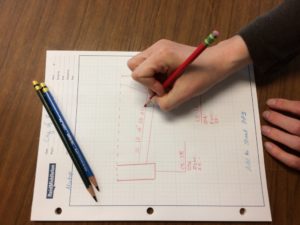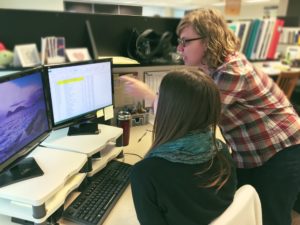Working as a transportation engineer in the Pacific Northwest has been a great gig. When I look back 10-years, as I headed home from WSU for the final time, I can honestly say that I had no idea how interesting, challenging, and rich my next years were going to be. I was lucky enough to graduate from college as the market for civil engineers was booming and Reid Middleton immediately scooped me up. As a new hire, I was then engaged to be a designer and eventually to become a civil/transportation engineer.
A lot has changed in ten years. Reid Middleton as an engineering, planning, and survey firm has evolved. As the oldest engineering firm in Snohomish County, Reid Middleton has grown and contracted with the market and yet remains a market lead in our disciplines. Some of the changes have been overnight while others happen so slowly they could even drive a crusty old engineer nuts. One of the fast-paced changes is our use of 3D modeling software.
Out with the Old
 Ten years ago the majority of our work was done with a red, blue, and green pencil. Engineers would sketch it up and drafters would draw it in AutoCad (whatever “it” was). Don’t get me wrong, we still have a few pencil sharpeners around the office and red pencil dust in every crevice of our work spaces, but now many of the 2D markups have become direct input to 3D digital models. Where we used to use crude 3D models primarily to calculate how much mud is in the mud hole or how much rock needs to be blasted away to build a new road, we now use a much more finely-tuned 3D model to design and inventory complex utility infrastructure, earth work computations, and fine grading.
Ten years ago the majority of our work was done with a red, blue, and green pencil. Engineers would sketch it up and drafters would draw it in AutoCad (whatever “it” was). Don’t get me wrong, we still have a few pencil sharpeners around the office and red pencil dust in every crevice of our work spaces, but now many of the 2D markups have become direct input to 3D digital models. Where we used to use crude 3D models primarily to calculate how much mud is in the mud hole or how much rock needs to be blasted away to build a new road, we now use a much more finely-tuned 3D model to design and inventory complex utility infrastructure, earth work computations, and fine grading.
In with the New
For many years we have been modeling roadway corridors, site development projects, and utility infrastructure, but now we take it to a new level. Current software has advanced to the point that we can build the models and efficiently show them in our plan sets for just about any project size or type. Setup is much less cumbersome and our plan sets are now “dynamic.” We can quickly and accurately model existing pipes and conduit buried beneath the roadway (even when it looks like a bowl of spaghetti) and then use the model to find the best placement for proposed utilities.
For roadway corridors, we can use 3D modeling to more quickly and efficiently generate accurate roadway geometry and elevations. Material quantities and impacts to a site can be analyzed immediately from the model. On a recent project in Redmond, along Union Hill Road, we were able to see huge returns for our client (the City of Redmond) by using 3D modeling. This project reconstructed the roadway, installed 1.6-miles of storm drain pipe, and completed multi-phase improvements to the corridor. The corridor already contained just about every buried utility possible, creating potential crossing conflicts with existing utilities (e.g. existing fiber optics, power, sewer, storm drain, water, high pressure gas, and more). As locations of existing utilities were refined we were able to update the entire model on the fly, to meet city standards. We were able to quickly smooth an undesirable roadway surface with immediate updates to our plan sheets. Not too many years ago this would have taken multiple days of markups, drafting, and quality control. Modeling helped to protect the project budget and schedule.
Two (Trained) Heads are Better than One
 Quality control practices have changed. As an engineer, it can be difficult to work in a 3D modeling environment and adequately provide quality control. A certain level of experience with the software is required to confidently interact with the model. At Reid Middleton we are constantly building/developing a system to guarantee the quality of our design work. As powerful as the software is for streamlining design it can be even more effective at helping with the QC process. Nearly any aspect of a design can be instantly labeled and reviewed allowing the engineer to quickly provide documentation and spend more time with the critical aspects of the site.
Quality control practices have changed. As an engineer, it can be difficult to work in a 3D modeling environment and adequately provide quality control. A certain level of experience with the software is required to confidently interact with the model. At Reid Middleton we are constantly building/developing a system to guarantee the quality of our design work. As powerful as the software is for streamlining design it can be even more effective at helping with the QC process. Nearly any aspect of a design can be instantly labeled and reviewed allowing the engineer to quickly provide documentation and spend more time with the critical aspects of the site.
The advancement of our design tools is exciting to observe. As we grow and advance at Reid Middleton, Civil 3D skills will continue to be an asset. We have a couple new PEs (Professional Engineers) this year and I expect each of them to teach me a new Civil 3D trick!

